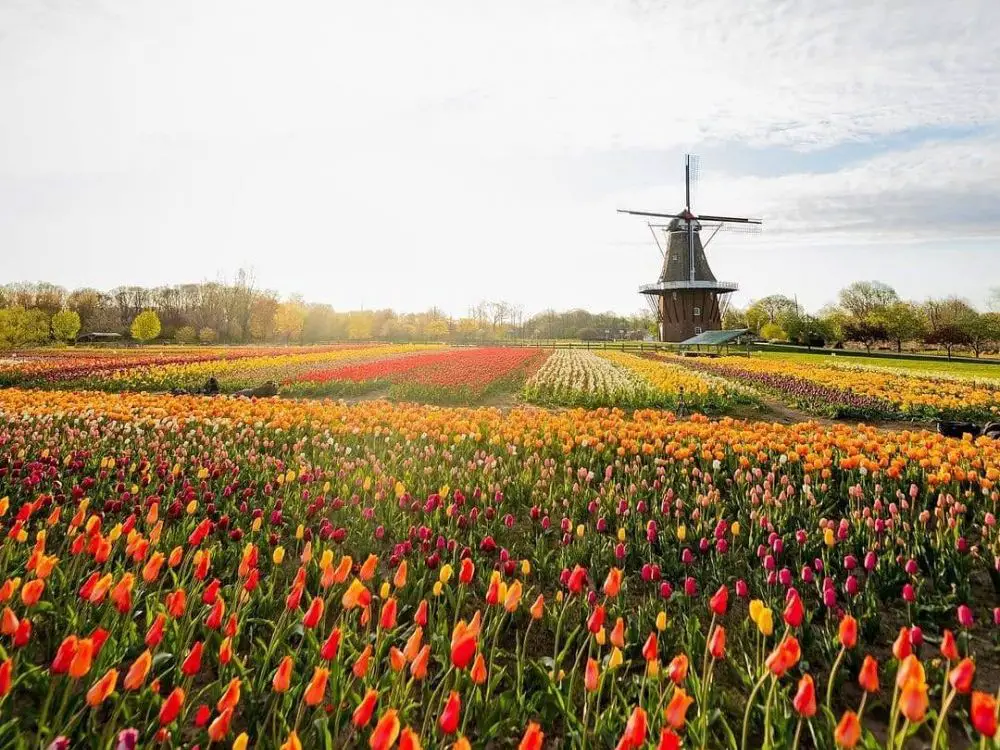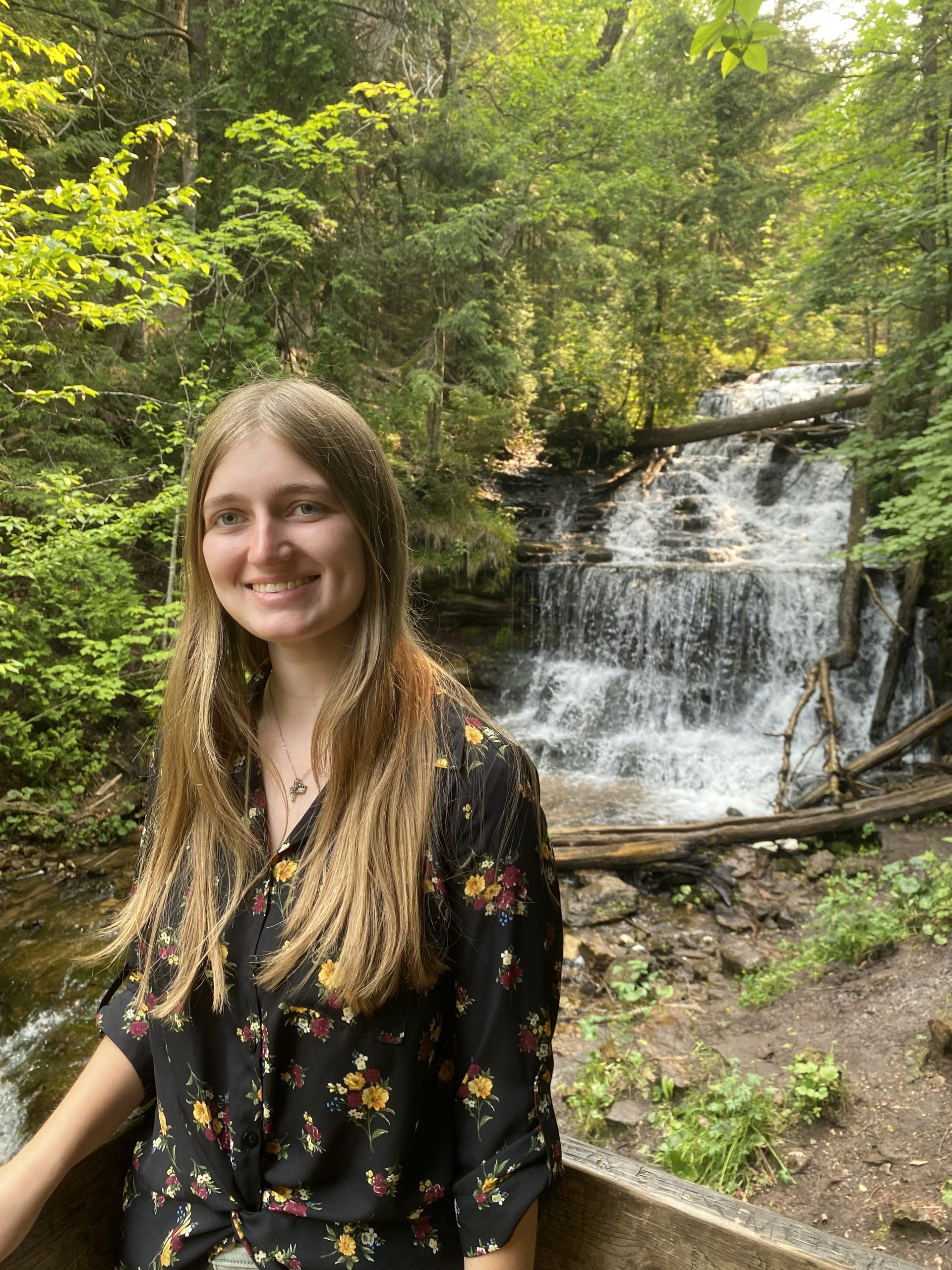Michigan’s beauty blossoms, no matter which season. Comprising two peninsulas, the “Great Lakes State” is bordered by Lake Michigan, Lake Superior, Lake Huron and Lake Erie, and connected by an amazing five-mile-long Mackinac Bridge. Michigan has five national parks and numerous state parks so you can enjoy its natural beauty. Whenever you take a vacation, Michigan will be there for you with many low-cost options and stunning views.
Spring in Michigan
In Michigan, spring lasts from March to May depending on how quickly the snow melts and how much the sun decides to shine.
Lower Peninsula: “April showers bring May flowers.” In Holland, Michigan, streets are lined with tulips, paying homage to the heritage of the original settlers. Tulip Time is an event that stretches over eight days with activities in different locations across Downtown Holland. Walk through parks filled with blooming flowers. Enjoy the rides and food of the carnival. See an authentic Dutch dance. A genuine windmill also graces the grounds. Carried over from the Netherlands and rebuilt brick by brick, De Zwaan is the only operating, authentic Dutch windmill in the United States. While there is an entrance fee, you can tour through the structure, whose stone wheels grind wheat into flour. You can also view 36 acres of gardens with over 100,000 tulips as well as canals from the fourth-floor deck.
Upper Peninsula: Michigan offers over 300 waterfalls, most of which are in the Upper Peninsula. As the snow melts, the deluge increases, making spring the best time to view the Upper Peninsula’s falls.
Tahquamenon Falls is the most popular waterfall. In the northeastern Upper Peninsula, Tahquamenon Falls features upper and lower falls. You can walk through a trail in the forest for four-and-half miles between the two, but are also able to drive to both. Nicknamed “Root Beer Falls,” tannins from nearby cedar swamps give the upper fall a brown color; water plummets 48 feet. The upper falls are visible only from an observation deck. However, the lower falls offer interaction and allow visitors to wade through the river. While water still rushes by, the lower falls feature more gradual cascading.
Spanning 92 square miles, the Porcupine Mountains are a small mountain range near the shore of Lake Superior and the Wisconsin border. The most popular view is at the Lake of the Clouds. The lake rests in a valley between two tree-covered mountain ridges and has an observation deck where you stand amid breathtaking nature. The mountains include many waterfalls, hiking trails, swimming areas and a campground.
An hour and a half drive south from the Porcupine Mountains is Bond Falls. The waterfall is special because it is not a single drop, but a series of falls, cascading 50 feet off jagged rocks into the pool below. You can view the rapids from a boardwalk, which also offers steps down to the water. Splashing in the water is both picturesque and fun.
Munising is a wonderful place to visit and serves as a good hub. The small town on Lake Superior’s coast includes 19 nearby waterfalls, including Munising Falls, Alger Falls, Wagner Falls, Horseshoe Falls and Mosquito Falls. The name of the latter is a good warning for all Michigan outdoor activities: Bring bug spray. Pictured Rocks also stretches along Munising’s coast. Take a boat to view the layered colored cliffs of limestone from Lake Superior. Nearby perches Miners Castle. While it once had the appearance of two castle turrets, a section collapsed due to erosion; this is one of the most famous formations of Pictured Rocks. From the easily accessible overlook, the shore curves and the aquamarine water of Lake Superior extends as far as the eye can see.
Summer
June, July and August clearly mark Michigan’s hottest months and that is when Michiganders take advantage of being surrounded by water. In Michigan, you are never more than six miles from a body of water.
With 3,288 miles, Michigan has the most freshwater coastline of all 50 states and is second in total shoreline only to Alaska — after all, four out of five Great Lakes border Michigan. Therefore, beaches are extremely prevalent in Michigan, and provide a fun way to escape the summer heat. Those who are not Michiganders may not understand the magnitude of the Great Lakes, which stretch to the horizon. Since the Great Lakes are so wide, you cannot see the other side, giving the feeling that you are swimming in the ocean. However, you don’t have to worry about sharks, jellyfish, or any other saltwater trouble. Popular beaches include Holland and Grand Haven in the Lower Peninsula. Many highways in the Upper Peninsula travel along lakes, and people frequently stop there to swim.
Lower Peninsula: Sleeping Bear Dunes rests on the western coast of Lake Michigan. Once said to resemble a bear, the sand dunes tower above the Great Lake. The story of the remarkable sight originates from a Native American legend; to escape a forest fire in Wisconsin, a mama bear and her two cubs swim across Lake Michigan to safety. Along the way, the two cubs drowned, but the mother reached the shore and climbed on top of a hill to wait for her babies. The Great Spirits created two islands to mark where the cubs drowned and a dune where the mother watched on the shore for her cubs. Stories like this are not uncommon to explain a natural occurrence. Sleeping Bear Dunes provides another opportunity to take a dip in a Great Lake with amazing scenery.
Upper Peninsula: In the southern-central section of the Upper Peninsula, Lake Kitch-iti-kipi is Michigan’s largest natural spring. The clear lake is 200 feet across and 45 degrees all year. Flowing over 10,000 gallons a minute, the body of water gives off a bright emerald color unlike anything you’ve ever seen. A glass-bottom raft takes visitors across the lake and then back. While the water can have a mirror-like surface, through the shade of the raft, you can see what lies 45 feet below. The springs at the bottom of the lake billow the lightly-colored sand. Tree roots, fallen branches and various types of fish milling about are also visible through the transparent waters. While lakes are common in Michigan, Kitch-iti-kipi is extraordinary.
With all the shoreline comes lighthouses, installed to protect ships from crashing into the shore. There are 129 lighthouses in Michigan, many of which allow access and a climb into the cupola for a breathtaking view of the water.
Fall
Hunting and visiting orchards are popular pastimes in Michigan. The weather shifts to cooler temperatures and nature responds.
As the temperature cools and the leaves acquire new shades, Michigan’s forests become filled with splashes of color. The reds, oranges, yellows, and a smattering of greens saturate the trees. The transition to winter also relieves the exertion that a hot summer day requires as you walk through the woods. Waterfalls and overlooks continue to be opportune viewing areas to witness the natural beauty. If you want specific suggestions, websites like this one provide some of the best places to experience fall colors. Seeing every shade of the color spectrum for miles offers a memorable escape.
Upper Peninsula: Every year in the last two weeks of August and the first of September, monarch butterflies arrive at Stonington Peninsula. A peninsula itself of the southwestern Upper Peninsula, the location finds the butterflies gathering on trees and bushes by the thousands! Dawn and right before sunset are the best times to see the winged creatures, but it takes some luck and several visits. However, the sight is worth it.
Winter
Winter seems to be the longest season, arguably stretching from late November to March. During this time in the water winter wonderland, the beauty doesn’t stop shining just because the sun did. Michiganders find ways to enjoy the chilly weather, like skiing, snowmobiling and ice fishing.
Beaches are not just for the summer. Lighthouses add to the beauty as winter sunsets on the coast provide a contrast of colors and create a burst of warm hues at the horizon against the dark waters. Frost coats the sandy coast and water continues to crash against jagged, frozen shores. But be prepared! Although the show is breathtaking, the shore winds blow sand into your eyes and mouth.
In the winter, the hundreds of waterfalls freeze, becoming ice caves. A different, largely unspoken beauty, the water becomes stalactites and creates a vertical sheet of ice. Depending on the size of the waterfall, only an outer shell may freeze, but for smaller cascades that completely become ice, you can walk on and behind the frozen stalactites, offering an unforgettable experience as you travel behind a frozen waterfall.
While the weather can be temperamental at times, Michigan’s natural beauty is always present and ready for you to enjoy.

















